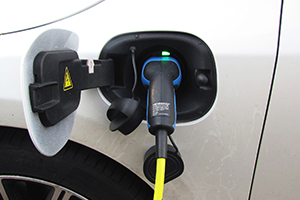Topic of the month October 2017: e-mobility
e-mobility
Recently, the topic of sustainability has not only reached our homes, but also our cars. The discussion about electromobility, but also its enablers and disablers, has become very topical.
One of the reasons is COP 21. The conventional internal combustion engine for the automobile is facing more and more challenges, and this is partly true due to the Paris Climate Agreement. Among the currently available alternative technologies, electric drive systems are in the lead, notwithstanding that the environmental footprint of an electric car strongly depends on the source of the electricity.
The automobile industry seems on the move. In addition to specialized companies such as Tesla or BYD, traditional carmakers are also investing more and more in the electro-mobility segment. In 2016, the market for electric vehicles grew by around 60% to almost 500,000 vehicles. It is true that in a comparison between gasoline, diesel and electric cars, battery-powered electric vehicles do better in relation to all environmentally relevant parameters, and compared to hybrid solutions as well. Their biggest advantage is clearly the lack of tailpipe emissions. In a broader ecological assessment, however, the emissions generated during the production of the energy must also be taken into consideration. The source of the electricity which is used to charge the battery is a key factor for the environmental footprint. Since CO2 is also generated during the production of electric cars as well, an adequate level of use is necessary to achieve an actual reduction in CO2 emissions; depending on the electricity mix this starts at around 30,000 kilometers and averages around 100,000 kilometers.
However, there are also a number of challenges faced by electro-mobility. Especially the development of more efficient, higher performance batteries deserves mention. Available battery systems are currently very heavy, have limited storage capacity, and suffer from performance problems at low temperatures. The infrastructure for charging batteries is also only now being developed, and the charging time ranges from just a few minutes for super chargers to several hours at a normal household connection. Plug-in hybrids function as a bundled solution and feature an electric motor with a battery, in addition to a traditional gasoline or diesel engine. For short distances, such as around town, it is possible to drive using the electric system only. As two technologies are used in parallel, plug-in hybrids are relatively expensive and heavy.
With regards to electro-mobility and the dimensions of Ecology, Social and Governance (ESG), the ecological topic (“E”) does, among others, comprise the topic of the ecological footprint. In a sensitivity analysis of the ecological footprints of gasoline, diesel, and electric cars, the results are strongly influenced by three factors - the driving situation, the battery lifespan, and the vehicle manufacturer. For urban driving conditions, the use of electric cars is perfect from an environmental perspective. Environmentally-relevant advantages also stem from the use of secondary materials in the production process. Vehicles with conventional drive trains are optimal for use outside of the urban environment. Compared to gasoline and diesel-powered vehicles, electric cars also perform far better in terms of nitrogen oxide (NOx) and particulate matter emissions. The social dimension of e-mobility (“S”) covers the cost of the new technology. Electro-mobility is currently still very expensive and thus unaffordable for all vehicle owners without massive subsidies.
The anticipated decline in prices should mitigate this social problem and help solve it in the future. Regarding the governance topic (“G”), national governments have the ability to significantly increase the share of electro-mobility, using legislation and regulations. The commitments of the individual countries under the Paris Climate Agreement mean that this kind of policy-making is indispensable based on the currently available technologies for drive trains.
At the moment, there are significant differences between countries in terms of the spread of electro-mobility. One key condition for market success is a suitable infrastructure and incentive models, which can include options such as the use of bus lanes, free parking or the use of public loading stations, in addition to financial incentives such as tax credits. In Europe, Norway is one of the leaders in this new field of technology, with more than 100,000 electric cars already sold. In the USA, the state of California also embraced the idea of electro-mobility very early.
The strategies within the auto industry seem very diverse when it comes to electro-mobility. The SRI team at Raiffeisen Capital Management (Raiffeisen Kapitalanlage GmbH) has taken a closer look at the major players and asked questions about the subject of electric cars and the related strategies for the future. The list of questions sent out included the companies’ general strategy on e-mobility on the one hand, but also the view on this very technology as a concept for the future on the other. Furthermore the topics of disablers – like batteries, consumer acceptance or infrastructure – were discussed. In Europe, the French auto manufacturers are amongst the very active players in the field of electromobility. The sustainability funds of Raiffeisen Capital Management currently focus on BMW. The company introduced the fully-electric BMW i3 on the market as early as 2013. In November 2016, BMW sold its 100,000th electric car. BMW’s current range of products has nine electric cars, including pure electric powered models and plug-in hybrids. By the year 2025, BMW expects that 15% to 25% of the vehicles it delivers will be electric cars and plug-in hybrids. BMW builds its conventional and electric vehicles on the same chassis, which improves production flexibility and makes it easier to react to possible changes in customer demand.
Raiffeisen Capital Management offers a sustainable mixed fund for investors who want to invest globally: Raiffeisen-Sustainable- Mix. The fund has an equity ratio of 50 per cent, and can thus reap the benefits of both the bond and the equity markets. The equities portion is broadly diversified and is invested in especially responsible and forward-looking companies in developed markets that are on solid financial footing and have good earnings development. The primary regions are Europe, North America, and Asia. In our opinion, the information technology and health care sectors are particularly promising at the moment, which is why they are currently stronger weighted in the fund. The Raiffeisen-Sustainable-Mix offers considerably higher return opportunities due to the equity ratio, but is also subject to significantly higher risk than a pure bond fund.
Investments in funds are subject to the risk of price fluctuations and capital losses.
The published prospectus as well as the key investor information for the Raiffeisen-Sustainable-Mix are available at www.rcm.at in German language and at www.rcm-international.com in English language.
Author: |
About Raiffeisen Capital Management Raiffeisen Capital Management (Raiffeisen Kapitalanlage GmbH) is part of Austria’s largest banking group and with a market share of 17 percent in investment funds one of the leading national Asset Management Companies. Since 2013, sustainable investment fund solutions are one of the core competencies of the company, with more than EUR 2.5 billion in assets, and a steady growing product range. The company currently manages EUR 31.7 billion in assets (as end of August 2017, incl. advisories), with institutional investors accounting for EUR 18 billion. For more information, visit us at www.rcm.at. All data as at 30 June 2017 |




